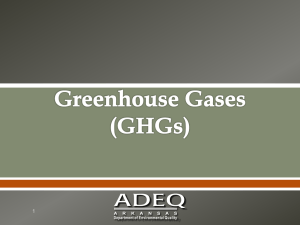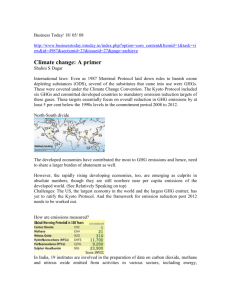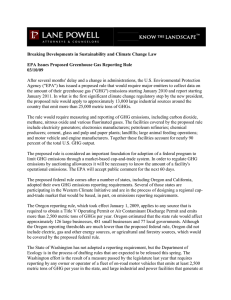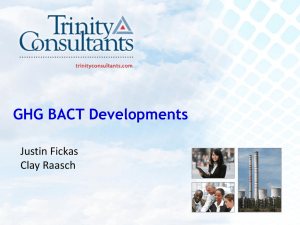Environmental, Land Use and Natural Resources Alert the Future
advertisement
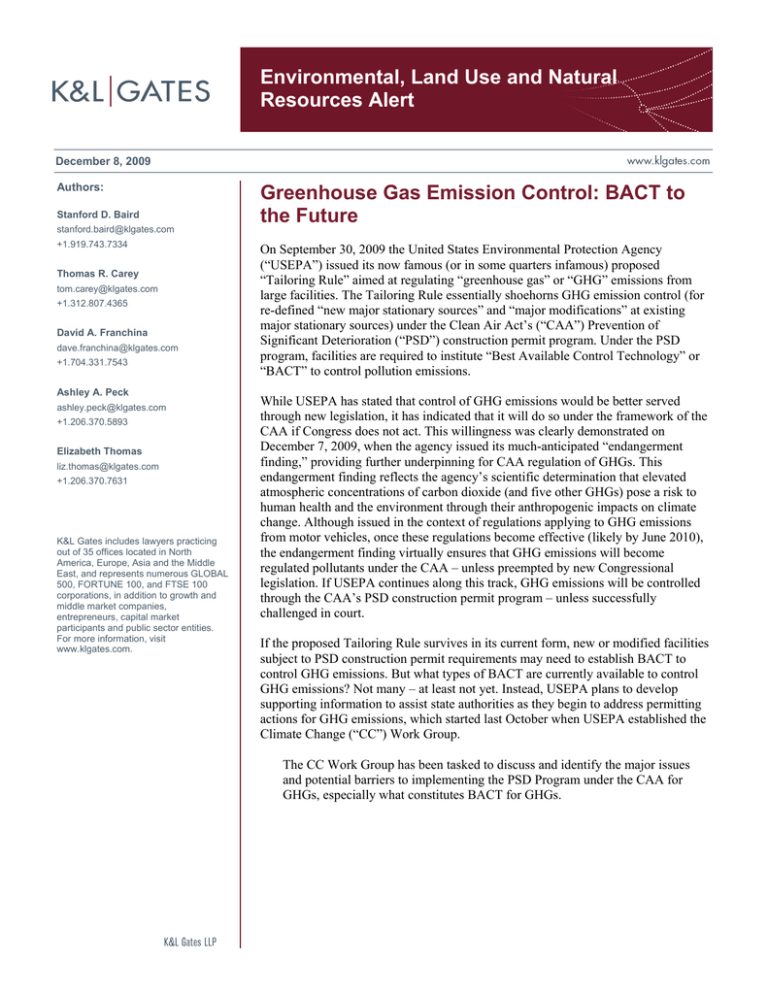
Environmental, Land Use and Natural Resources Alert December 8, 2009 Authors: Stanford D. Baird stanford.baird@klgates.com +1.919.743.7334 Thomas R. Carey tom.carey@klgates.com +1.312.807.4365 David A. Franchina dave.franchina@klgates.com +1.704.331.7543 Ashley A. Peck ashley.peck@klgates.com +1.206.370.5893 Elizabeth Thomas liz.thomas@klgates.com +1.206.370.7631 K&L Gates includes lawyers practicing out of 35 offices located in North America, Europe, Asia and the Middle East, and represents numerous GLOBAL 500, FORTUNE 100, and FTSE 100 corporations, in addition to growth and middle market companies, entrepreneurs, capital market participants and public sector entities. For more information, visit www.klgates.com. Greenhouse Gas Emission Control: BACT to the Future On September 30, 2009 the United States Environmental Protection Agency (“USEPA”) issued its now famous (or in some quarters infamous) proposed “Tailoring Rule” aimed at regulating “greenhouse gas” or “GHG” emissions from large facilities. The Tailoring Rule essentially shoehorns GHG emission control (for re-defined “new major stationary sources” and “major modifications” at existing major stationary sources) under the Clean Air Act’s (“CAA”) Prevention of Significant Deterioration (“PSD”) construction permit program. Under the PSD program, facilities are required to institute “Best Available Control Technology” or “BACT” to control pollution emissions. While USEPA has stated that control of GHG emissions would be better served through new legislation, it has indicated that it will do so under the framework of the CAA if Congress does not act. This willingness was clearly demonstrated on December 7, 2009, when the agency issued its much-anticipated “endangerment finding,” providing further underpinning for CAA regulation of GHGs. This endangerment finding reflects the agency’s scientific determination that elevated atmospheric concentrations of carbon dioxide (and five other GHGs) pose a risk to human health and the environment through their anthropogenic impacts on climate change. Although issued in the context of regulations applying to GHG emissions from motor vehicles, once these regulations become effective (likely by June 2010), the endangerment finding virtually ensures that GHG emissions will become regulated pollutants under the CAA – unless preempted by new Congressional legislation. If USEPA continues along this track, GHG emissions will be controlled through the CAA’s PSD construction permit program – unless successfully challenged in court. If the proposed Tailoring Rule survives in its current form, new or modified facilities subject to PSD construction permit requirements may need to establish BACT to control GHG emissions. But what types of BACT are currently available to control GHG emissions? Not many – at least not yet. Instead, USEPA plans to develop supporting information to assist state authorities as they begin to address permitting actions for GHG emissions, which started last October when USEPA established the Climate Change (“CC”) Work Group. The CC Work Group has been tasked to discuss and identify the major issues and potential barriers to implementing the PSD Program under the CAA for GHGs, especially what constitutes BACT for GHGs. Environmental, Land Use and Natural Resources Alert In announcing the formation of the group, USEPA stated, in part: Addressing the challenge of climate change will require a well-coordinated effort. Actions by USEPA to provide information and policy guidance to assist states and regulated entities implementing measures to reduce GHGs under the Clean Air Act would facilitate more efficient and consistent implementation, particularly in key areas such as permitting under the Prevention of Significant Deterioration (PSD) Program and the assessment of Best Available Control Technology. BACT determinations for any given facility are typically negotiated between the permittee and state air permitting authorities on a case-by-case basis and screened through the lens of an energy, environmental, and economic impact analysis. To assist the states and permittees in this regard, USEPA has established a searchable central database of air pollution technology to promote the sharing of such information and to aid in the selection of appropriate emission controls for any given project. Neither this database nor the proposed Tailoring Rule, however, provides any guidance on what types of technical controls will constitute BACT for various GHG emission sources. This will be the job of the CC Work Group. And they have their work cut out for them. Why? Because currently there are no CO2-capture technologies – like scrubbers or oxidizers – that can be slapped onto an emission source for BACT purposes. The most cost-effective way recognized to control GHG emissions is through increasing petroleumbased fuel burning efficiencies (less fuel use = less CO2 emissions) in boilers, engines, and other fuel combustion devices. Other emission “controls” could include switching from high CO2 emission fuels like coal and fuel oil to lower emission fuels like natural gas. While carbon capture and sequestration are being studied at several levels, these technologies likely will not be commercially available for many years – if at all. The USEPA’s Environmental Appeals Board rendered a decision recently that instructed USEPA to demonstrate why integrated gasification combined cycle (“IGCC”) for a proposed coal-fired power plant should not be considered BACT for the facility. IGCC is a technology that turns coal into “synthesis gas” before it is combusted. The process is extremely clean and more efficient than traditional coal-fired systems, but very expensive to construct and operate. Furthermore, the proposed Tailoring Rule potentially applies to numerous facilities outside the utility sector (e.g., agriculture, chemical manufacturing, transportation equipment manufacturing, waste management, etc.). Use of IGCC, increased efficiency, or fuel changes may be limited for such facilities for BACT purposes. The CC Work Group will focus, in part, on developing information and guidance to help USEPA establish the technical, economic, and environmental performance characteristics of potential GHG BACT options. In addition, the Work Group has been tasked to identify and discuss approaches to enable state and local permitting authorities to apply the BACT criteria for GHGs in a consistent, practical, and efficient manner. It will also help permitting authorities and the regulated community keep to a minimum the legal challenges to GHG BACT determinations that are likely as this new area of law is developed. The CC Work Group held its first meeting on November 4, 2009 and reportedly established several issue-based teams. One team has been tasked to focus on how states can make the BACT process work, including how to assemble and analyze data needed to make BACT determinations for GHGs. Another team will focus on defining GHG source types. Other teams will focus on potential GHG BACT technologies to be considered and others that should be ruled out. The CC Work Group is expected to convene for a six-month period through March 2010 – the date USEPA’s related GHG mobile source regulations are slated to be promulgated. The CC Work Group will issue a draft interim report on or before December 31, 2009. A draft final report is expected on or before March of 2010. The draft final report is expected to be approximately ten pages (or less) in length and identify technical, economic, environmental and other information that would be useful to enable sources and permitting authorities to implement BACT for GHGs. The proposed length of the draft final report suggests that it will be merely a starting point for GHG BACT analysis December 8, 2009 2 Environmental, Land Use and Natural Resources Alert rather than a comprehensive guide. It also suggests, in the words of Shakespeare’s Polonius (right-hand man of Hamlet's stepfather, King Claudius) that at least in the eyes of USEPA, “brevity is the soul of wit,” for GHG BACT purposes. Anchorage Austin Beijing Berlin Boston Charlotte Chicago Dallas Dubai Fort Worth Frankfurt Harrisburg Hong Kong London Los Angeles Miami Moscow Newark New York Orange County Palo Alto Paris Pittsburgh Portland Raleigh Research Triangle Park San Diego San Francisco Seattle Shanghai Singapore Spokane/Coeur d’Alene Taipei Tokyo Washington, D.C. K&L Gates includes lawyers practicing out of 35 offices located in North America, Europe, Asia and the Middle East, and represents numerous GLOBAL 500, FORTUNE 100, and FTSE 100 corporations, in addition to growth and middle market companies, entrepreneurs, capital market participants and public sector entities. For more information, visit www.klgates.com. K&L Gates is comprised of multiple affiliated entities: a limited liability partnership with the full name K&L Gates LLP qualified in Delaware and maintaining offices throughout the United States, in Berlin and Frankfurt, Germany, in Beijing (K&L Gates LLP Beijing Representative Office), in Dubai, U.A.E., in Shanghai (K&L Gates LLP Shanghai Representative Office), in Tokyo, and in Singapore; a limited liability partnership (also named K&L Gates LLP) incorporated in England and maintaining offices in London and Paris; a Taiwan general partnership (K&L Gates) maintaining an office in Taipei; a Hong Kong general partnership (K&L Gates, Solicitors) maintaining an office in Hong Kong; and a Delaware limited liability company (K&L Gates Holdings, LLC) maintaining an office in Moscow. K&L Gates maintains appropriate registrations in the jurisdictions in which its offices are located. A list of the partners or members in each entity is available for inspection at any K&L Gates office. This publication is for informational purposes and does not contain or convey legal advice. The information herein should not be used or relied upon in regard to any particular facts or circumstances without first consulting a lawyer. ©2010 K&L Gates LLP. All Rights Reserved. December 8, 2009 3


